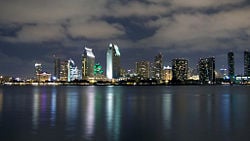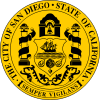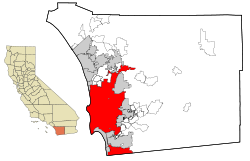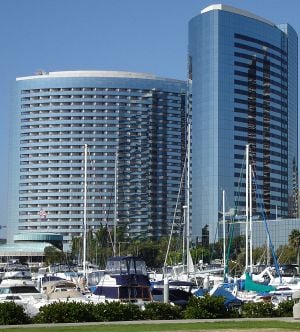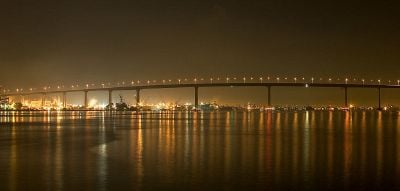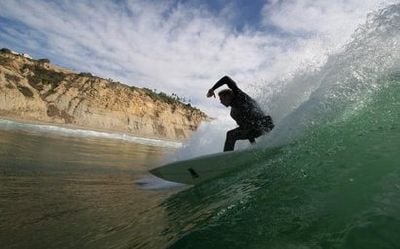| San Diego | |||||||||||
| — City — | |||||||||||
| City of San Diego | |||||||||||
| San Diego Skyline | |||||||||||
|
|||||||||||
| Nickname: America's Finest City | |||||||||||
| Motto: Semper Vigilans (Latin for "Ever Vigilant") | |||||||||||
| Location of San Diego within San Diego County |
|||||||||||
| Country | United States | ||||||||||
|---|---|---|---|---|---|---|---|---|---|---|---|
| State | California | ||||||||||
| County | San Diego | ||||||||||
| Founded | July 16, 1769 | ||||||||||
| Incorporated | March 27, 1850 | ||||||||||
| Government | |||||||||||
| - Type | Mayor-council | ||||||||||
| - Mayor | Todd Gloria | ||||||||||
| - City Attorney | Mara Elliott | ||||||||||
| Area | |||||||||||
| - City | 372.398 sq mi (964.506 km²) | ||||||||||
| - Land | 325.188 sq mi (842.233 km²) | ||||||||||
| - Water | 47.210 sq mi (122.273 km²) 12.68% | ||||||||||
| Elevation | 72–400 ft (22 m) | ||||||||||
| Population (2020)[3] | |||||||||||
| - City | 1,386,932 | ||||||||||
| - Density | 4,255.96/sq mi (1,643.25/km²) | ||||||||||
| - Urban | 3,070,300[2] (US: 15th) | ||||||||||
| - Urban Density | 4,550.5/sq mi (1,756.9/km²) | ||||||||||
| - Metro | 3,276,208[1] (US: 18th) | ||||||||||
| Time zone | PST (UTC-8) | ||||||||||
| - Summer (DST) | PDT (UTC-7) | ||||||||||
| ZIP code | 92101-92117, 92119-92124, 92126-92140, 92142, 92145, 92147, 92149-92155, 92158-92172, 92174-92177, 92179, 92182, 92184, 92186, 92187, 92190-92199 | ||||||||||
| Area code(s) | 619, 858 | ||||||||||
| FIPS code | 66000 | ||||||||||
| GNIS feature ID | 1661377 | ||||||||||
|
|||||||||||
| Website: www.sandiego.gov | |||||||||||
San Diego is a large coastal California city located in the southwestern corner of the continental United States. It is the second largest city in California and the eighth largest city in the nation, by population. It is also the county seat of San Diego County and is the economic center of the San Diego–Carlsbad–San Marcos metropolitan area.
It lies along the Pacific Ocean at San Diego Bay just north of the Mexican border. San Diego County, just south of Orange County, shares a border with Tijuana. With no natural border, the San Diego sector traditionally has been the preferred location for illegal immigration from Mexico into the U.S., accounting for more than 40 percent of the Border Patrol's total apprehensions of illegal immigrants each year, straining local resources.
San Diego is home to 70 miles of beaches and has a mild Mediterranean climate and 16 military facilities hosting the United States Navy, the United States Coast Guard, and the United States Marine Corps. The presence of the University of California, San Diego (UCSD) with its affiliated UCSD Medical Center promotes research in biotechnology. Its economy is largely composed of agriculture, biotechnology/biosciences, computer sciences, electronics manufacturing, defense-related manufacturing, financial and business services, ship repair and construction, software development, telecommunications, and tourism.
Geography
The city of San Diego has deep canyons separating its mesas, creating small pockets of natural parkland scattered throughout the city. These canyons give parts of the city a highly segmented feel, creating literal gaps between neighborhoods and contributing to a low-density, car-centered environment. Downtown San Diego is located on San Diego Bay. Balboa Park lies on a mesa to the northeast. It is surrounded by several dense urban communities and abruptly ends in Hillcrest to the north.
The Coronado and Point Loma peninsulas separate San Diego Bay from the ocean. Ocean Beach is on the west side of Point Loma. Mission Beach and Pacific Beach lie between the ocean and Mission Bay, a man-made aquatic park. La Jolla, an affluent community, lies north of Pacific Beach. Mountains rise to the east of the city, and beyond the mountains are desert areas. Cleveland National Forest is a half-hour drive from downtown San Diego. Numerous farms are found in the valleys northeast and southeast of the city.
San Diego County has one of the highest counts of animal and plant species that appear on the endangered species list among counties in the United States.
Climate
San Diego has a Mediterranean, or semi-arid, climate. The city enjoys mild, mostly dry days and plenty of sunshine throughout the year with 264 sunshine days annually.[4] Temperatures vary little throughout the year.
Summer or dry period of May to October are mild to warm with average high temperatures of 70-78°F (21-26°C) and lows of 55-66°F (13-19°C), and temperatures only exceed 90°F (32°C) four days a year. Winters, or the rainy period of November to April, are mild and somewhat rainy with high temperatures of 66-70°F (19-21°C) and lows of 50-56°F (10-13°C).
Climate in the San Diego area and the rest of California often varies dramatically over short geographical distances, due to the city's topography (the Bay, and the numerous hills, mountains, and canyons). Particularly during the "May gray / June gloom" period, a thick "marine layer" cloud cover will keep the air cool and damp within a few miles of the coast, but will yield to bright cloudless sunshine between about 5 and 15 miles (9-24 km) inland—the cities of El Cajon and Santee for example, rarely experience the cloud cover. This phenomenon is known as a microclimate.
Rainfall averages about 10 inches (251 mm) of precipitation annually, mainly during the cooler months of December through April.
Ecology
Like most of southern California, the majority of San Diego's current area was originally occupied by chaparral, a plant community made up mostly of drought-resistant shrubs. The endangered Torrey pine has the bulk of its population in San Diego in a stretch of protected chaparral along the coast.
The steep, varied topography and proximity to the ocean create a number of different habitats within the city limits, including tidal marsh and canyons. The influence of humans has altered existing habitats and has also created habitats that did not exist prior to human development, by construction of buildings, the introduction of new species, and the use of water for lawns and gardens. A number of species of parrots, including the Red-masked Parakeet and Red-crowned Amazon, have established feral populations in urban neighborhoods such as Ocean Beach.
San Diego's broad city limits encompass a number of large nature preserves, including Torrey Pines State Reserve, Border Field State Park, Mission Trails Regional Park. Torrey Pines State Preserve, and a coastal strip continuing to the north is the only location where the rare species of Torrey Pine, P. torreyana torreyana, is found. Due to a combination of the steep topography that prevents or discourages building, and some efforts for preservation, there are also a large number of canyons within the city limits that are nature preserves, including Tecolote Canyon Natural Park and Marian Bear Memorial Park in the San Clemente Canyon, as well as a number of small parks and preserves.
Fire
The chaparral and coastal sage scrub habitats in low elevations along the coast are prone to wildfire, and the rates of fire have increased in the 20th century, due primarily to fires starting near the borders of urban and wild areas. In 2003, San Diego was the site of what has been called the largest wildfire in California over the past century. In addition to damage caused by the fire, smoke from the fire resulted in a significant increase in emergency room visits due to asthma, respiratory problems, eye irritation, and smoke inhalation.
History
The area has long been inhabited by the Kumeyaay people. The first European to visit the region was Portuguese explorer Juan Rodrigues Cabrillo, sailing under the Spanish flag, who claimed the bay for the Spanish Empire.
In November 1602, Sebastián Vizcaíno was sent to map the California coast. Vizcaíno surveyed the harbor and what are now Mission Bay and Point Loma and named the area for the Catholic Saint Didacus, a Spaniard more commonly known as "San Diego."
In 1769, Gaspar de Portolà established the Presidio of San Diego (a military post) overlooking Old Town. Around the same time, Mission San Diego de Alcalá was founded by Franciscan friars under Father Junípero Serra. By 1797, the mission boasted the largest native population in Alta California, with over 1,400 neophytes living in and around the mission.
After New Spain won its independence from the Spanish Empire, the mission's fortunes declined with the decree of secularization, as was the case with all of the missions under the control of Mexico.
The end of the Mexican-American War and the California Gold Rush of 1848 drew a wave of settlers. San Diego was designated the seat of the newly established San Diego County and was incorporated as a city in 1850.
A significant U.S. naval presence began in 1907 with the establishment of the Navy Coaling Station, which gave further impetus to the town's development. San Diego hosted two World's Fairs, the Panama-California Exposition in 1915, and the California Pacific International Exposition in 1935.
After World War II, the military played an increasing role in the local economy, but post-Cold War cutbacks took a heavy toll on the local defense and aerospace industries. The resulting downturn led San Diego leaders to seek to diversify the city's economy, and San Diego has since become a major center of the emerging biotechnology industry. It is also home to telecommunications giant Qualcomm.
Downtown San Diego has been undergoing an urban renewal since the early 1980s. The Centre City Development Corporation (CCDC), San Diego's downtown redevelopment agency, has transformed what was a largely abandoned area into a glittering showcase of waterfront skyscrapers, five-star hotels, and many cafés, restaurants, and boutiques.
A series of scandals has rocked the city in recent years. Two city council members were convicted of extortion, wire fraud, and conspiracy to commit wire fraud for taking campaign contributions from a strip club owner and his associates, allegedly in exchange for trying to repeal the city's "no touch" laws at strip clubs. Both subsequently resigned. In 2005, U.S. Congressman Randy "Duke" Cunningham resigned over a bribery scandal and is serving a 100-month prison sentence.
In 2008, plummeting tax revenues due to the nation's financial crisis led Mayor Jerry Sanders to make severe cuts in his fiscal 2009 budget, needed to close a $43 million gap.
Economy
The three largest sectors of San Diego's economy are defense, manufacturing, and tourism, respectively. Several areas of San Diego (in particular La Jolla and surrounding Sorrento Valley) are home to offices and research facilities for numerous biotechnology companies. Major biotechnology companies are headquartered in San Diego, while many biotech and pharmaceutical companies have offices or research facilities in San Diego. There are also several non-profit biotech institutes, such as the Salk Institute for Biological Studies, the Scripps Research Institute, and the Burnham Institute. The presence of University of California, San Diego and other research institutions helped fuel biotechnology growth. In June 2004, San Diego was ranked the top biotech cluster in the United States by the Milken Institute.
San Diego is also home to companies that develop wireless cellular technology. Qualcomm Incorporated was founded and is headquartered in San Diego; Qualcomm is the largest private-sector technology employer (excluding hospitals) in San Diego County. The largest software company in San Diego is security software company Websense Inc.
The economy of San Diego is influenced by its port, which includes the only major submarine and shipbuilding yards on the West Coast, as well as the largest naval fleet in the world. The cruise ship industry is the second largest in California after Los Angeles.
Due to San Diego's military influence, major national defense contractors, such as General Atomics and Science Applications International Corporation are headquartered in San Diego.
Tourism is also a major industry owing to the city's climate. Major tourist destinations include Balboa Park, the San Diego Zoo, Seaworld, nearby Wild Animal Park, and Legoland, the city's beaches, and golf tournaments like the Buick Invitational.
Military
Military bases in San Diego include U.S. Navy ports, Marine Corps bases, and Coast Guard stations. One of the Marine Corps' two Recruit Depots is located in San Diego. San Diego is the site of one of the largest naval fleets in the world, and San Diego has become the largest concentration of naval facilities in the world due to base reductions at Norfolk, Virginia, and retrenchment of the Russian naval base in Vladivostok. Two of the U.S. Navy's Nimitz class supercarriers, (the USS Nimitz and the USS Ronald Reagan), five amphibious assault ships, several Los Angeles class "fast attack" submarines, the Hospital Ship USNS Mercy, carrier and submarine tenders, destroyers, cruisers, frigates, and many smaller ships are home-ported there.
Transportation
Public transportation
Less than 3 percent of San Diego residents use mass transit. San Diego is served by trolley, bus, Coaster trains, and Amtrak. The trolley primarily serves downtown and surrounding urban communities, though there are plans to expand it. Buses are available along most major routes, though a large number of bus stops are concentrated in central San Diego. Ferries are also available every half hour crossing San Diego Bay to Coronado.
Cycling
San Diego's roadway system provides an extensive network of routes for travel by bicycle. The dry and mild climate of San Diego makes cycling a convenient and pleasant year-round option. At the same time, the city's hilly, canyoned terrain and significantly long average trip distances—brought about by strict low-density zoning laws—somewhat restrict cycling for utilitarian purposes.
Air
San Diego International Airport, also known as Lindbergh International Airport or Lindbergh Field, is the primary commercial airport serving San Diego. It is the busiest single-runway airport in the United States, serving over 17 million passengers every year, and is located on San Diego Bay three miles from downtown.
Sea
The Port of San Diego manages the maritime operations of San Diego harbor. Cruise ships arrive and depart from San Diego's cruise ship terminal at the foot of Broadway downtown. Carnival Cruise Lines, Royal Caribbean, Holland America, and Celebrity Cruises have home port cruise ships in San Diego during the winter season. An additional cruise terminal at Embarcadero Circle is set to open in 2010. San Diego's port also manages a significant cargo operation that includes imports from South America; motor vehicle imports from Germany, Italy, Sweden, Japan, and the United Kingdom; and other trade operations.
San Diego is home to General Dynamics' National Steel and Shipbuilding Company (NASSCO), the largest shipyard on the West Coast of the United States. It is capable of building and repairing large ocean-going vessels. The yard constructs commercial cargo ships and auxiliary vessels for the U.S. Navy and Military Sealift Command, which it has served since 1960.
Education
Primary and secondary schools
The San Diego Unified School District, also known as San Diego City Schools, serves the majority of the city. It includes 113 elementary schools, 23 middle schools, 4 atypical schools, 10 alternative schools, 27 high schools, and 25 charter schools.
Colleges and universities
Public colleges and universities in the city include University of California, San Diego (UCSD), San Diego State University (SDSU), and the San Diego Community College District. There are also a number of private colleges and universities in the city. There is one medical school in the city, the UCSD School of Medicine. The three ABA-accredited law schools are California Western School of Law, Thomas Jefferson School of Law, and University of San Diego School of Law.
Culture
Many popular museums, such as the San Diego Museum of Art, the San Diego Natural History Museum, the San Diego Museum of Man, and the Museum of Photographic Arts are located in Balboa Park. The Museum of Contemporary Art San Diego is located in an oceanfront building in La Jolla and has a branch located downtown. The Columbia district downtown is home to historic ship exhibits as well as the San Diego Aircraft Carrier Museum, featuring the USS Midway aircraft carrier.
San Diego has a growing art scene. "Kettner Nights" in Little Italy has art and design exhibitions throughout many retail design stores and galleries on selected Friday nights. "Ray at Night" at North Park hosts a variety of small-scale art galleries on the second Saturday evening of each month. La Jolla and nearby Solana Beach also have a variety of art galleries.
The San Diego Symphony at Symphony Towers performs on a regular basis. The San Diego Opera at Civic Center Plaza was ranked by Opera America as one of the top 10 opera companies in the United States. Old Globe Theatre at Balboa Park produces about 15 plays and musicals annually. The La Jolla Playhouse at UCSD is directed by Christopher Ashley. The Joan B. Kroc Theatre at Kroc Center's Performing Arts Center is a 600-seat state-of-the-art theater that hosts music, dance, and theater performances. The San Diego Repertory Theatre at the Lyceum Theatres in Horton Plaza produces a variety of plays and musicals. Serving the northeastern part of San Diego is the California Center for the Arts in Escondido, a 400-seat performing arts theater.
Tourism has affected the city's culture, as San Diego houses many tourist attractions, such as SeaWorld San Diego, Belmont amusement park, San Diego Zoo, San Diego Wild Animal Park, and nearby Legoland. San Diego's Spanish influence can be seen in many historic sites across the city, such as the Spanish missions and Balboa Park.
San Diego has also attracted those who are part of the surfing and skateboarding cultures. Businesses catering to these cultures have their headquarters here.
Sports
San Diego has several sports venues: Qualcomm Stadium is the home of the NFL's San Diego Chargers. It also hosts international soccer games. Three NFL Super Bowl championships and many college football bowl games have been held there. Balboa Stadium, the city's first stadium, hosts soccer, American football, and track and field.
PETCO Park in downtown San Diego is the home of Major League Baseball's San Diego Padres. Other than baseball, PETCO Park hosts soccer and rugby events. The San Diego Sports Arena hosts basketball, and has also hosted ice hockey, indoor soccer, and boxing.
San Diego has the dubious distinction of being the largest United States city to have not won a Super Bowl, World Series, Stanley Cup, NBA Finals, or any other major league sports championship; this is known as the San Diego Sports Curse.
Looking to the future
There is no natural barrier between the United States and Mexico in the San Diego section of the border. Local officials say illegal immigrants have strained local education, health care, and law enforcement resources. The San Diego sector traditionally has been the preferred location for illegal immigration from Mexico into the United States, and typically accounts for more than 40 percent of the Border Patrol's total apprehensions of illegal immigrants each year. But a federal crackdown that began in 1994 is reducing the numbers. In the five-mile stretch of the border between the San Ysidro and Otay Mesa ports of entry, fencing was raised and reinforced with razor-studded concertina wire. Since completion of the wire project in late 2008, both illegal-crossing arrests and assaults against agents in the area are down by more than 50 percent.
The city is committed to a "smart growth" development scheme that would increase density along transit corridors in older neighborhoods (the "City of Villages" planning concept.) Some neighborhoods are resisting this planning approach, but "mixed-use development" has had its successes. A pilot program is designed to build working examples.
Villages address growth and improve existing communities by combining housing, commercial, employment centers, schools, and public/civic uses together in areas where a high level of activity already exists. The plan is intended to create a lively, walkable, and unique atmosphere that builds upon existing neighborhoods and promotes revitalization. Connecting villages with an improved transit system will help them reach their full potential.
In the early twenty-first century California in general and the city of San Diego experiencing prolonged drought, that led the city to implement a voluntary water conservation program. The lack of sufficient water and the need for conservation are likely to continue.
Notes
- ↑ 2020 Population and Housing State Data United States Census Bureau. Retrieved October 31, 2023.
- ↑ Urban and Rural United States Census Bureau. Retrieved October 31, 2023.
- ↑ QuickFacts: San Diego city, California United States Census Bureau. Retrieved October 31, 2023.
- ↑ San Diego, California Weatherbase. Retrieved October 31, 2023.
ReferencesISBN links support NWE through referral fees
- Chartkoff, Joseph L., and Kerry Kona Chartkoff. The Archaeology of California. Stanford: Stanford University Press, 1984. ISBN 0804711577
- Fodor's. Fodor's San Diego: With North County. New York: Fodor's, 2013. ISBN 978-0891419426
- Pelta, Kathy. California. Minneapolis, MN: Lerner Publications, 2002. ISBN 0822540622
External links
All links retrieved October 13, 2023.
- San Diego CityTownInfo.
- Why Pilot Villages are Important The City of San Diego.
- The City of San Diego.
- San Diego History Center.
- San Diego Regional Economic Development Corporation.
Credits
New World Encyclopedia writers and editors rewrote and completed the Wikipedia article in accordance with New World Encyclopedia standards. This article abides by terms of the Creative Commons CC-by-sa 3.0 License (CC-by-sa), which may be used and disseminated with proper attribution. Credit is due under the terms of this license that can reference both the New World Encyclopedia contributors and the selfless volunteer contributors of the Wikimedia Foundation. To cite this article click here for a list of acceptable citing formats.The history of earlier contributions by wikipedians is accessible to researchers here:
The history of this article since it was imported to New World Encyclopedia:
Note: Some restrictions may apply to use of individual images which are separately licensed.
